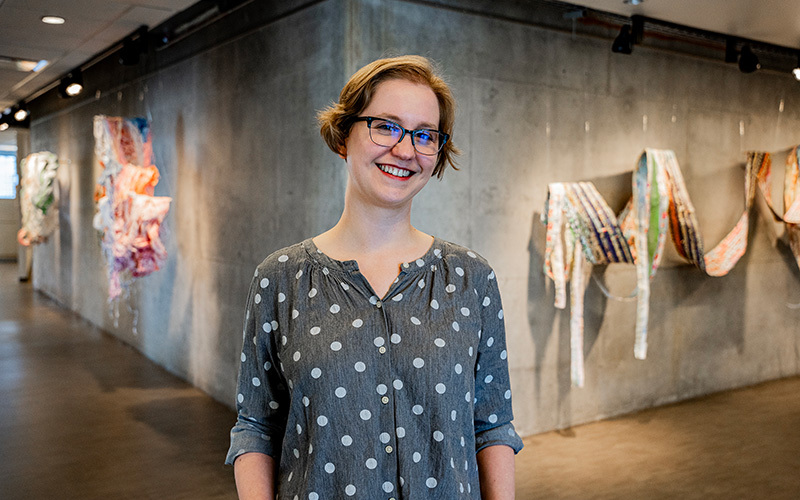For artist Astri Snodgrass, Artwork Archive hasn’t just tamed her inventory, it’s given her a new way to reflect on her practice. Photo credit: Travis Estvold.
When Spreadsheets Fall Short for Artists
When artist Astri Snodgrass graduated from her MFA program, she was overwhelmed. She was making plenty of work, but she lacked perspective on how her practice was evolving, and couldn’t figure out which new opportunities she wanted to pursue.
The artist was trying to use spreadsheets to keep track of her artwork inventory but found it impossible to include images without the spreadsheet files becoming impossibly large. After crashing her computer a few times, “I pivoted to tracking images elsewhere, but that got really messy and confusing. So really, it wasn’t functional.”
Then she found Artwork Archive. Using Artwork Archive’s simple inventory tools, Snodgrass was able to quickly get a holistic view of her whole practice. She found that she could easily upload a photo of a new work, and add all the information she might need to know about it, including dimensions, medium, pricing, insurance value, and more.
“Once I familiarized myself with the inventory tracking process,” she says, “I felt empowered to do it more frequently and create a workflow for when and how I’d approach the task.”
In this installment of our Art Business Diaries series, Snodgrass provides an in-depth Artwork Archive review, sharing all the features she uses to make her creative life easier and more artistically fulfilling.
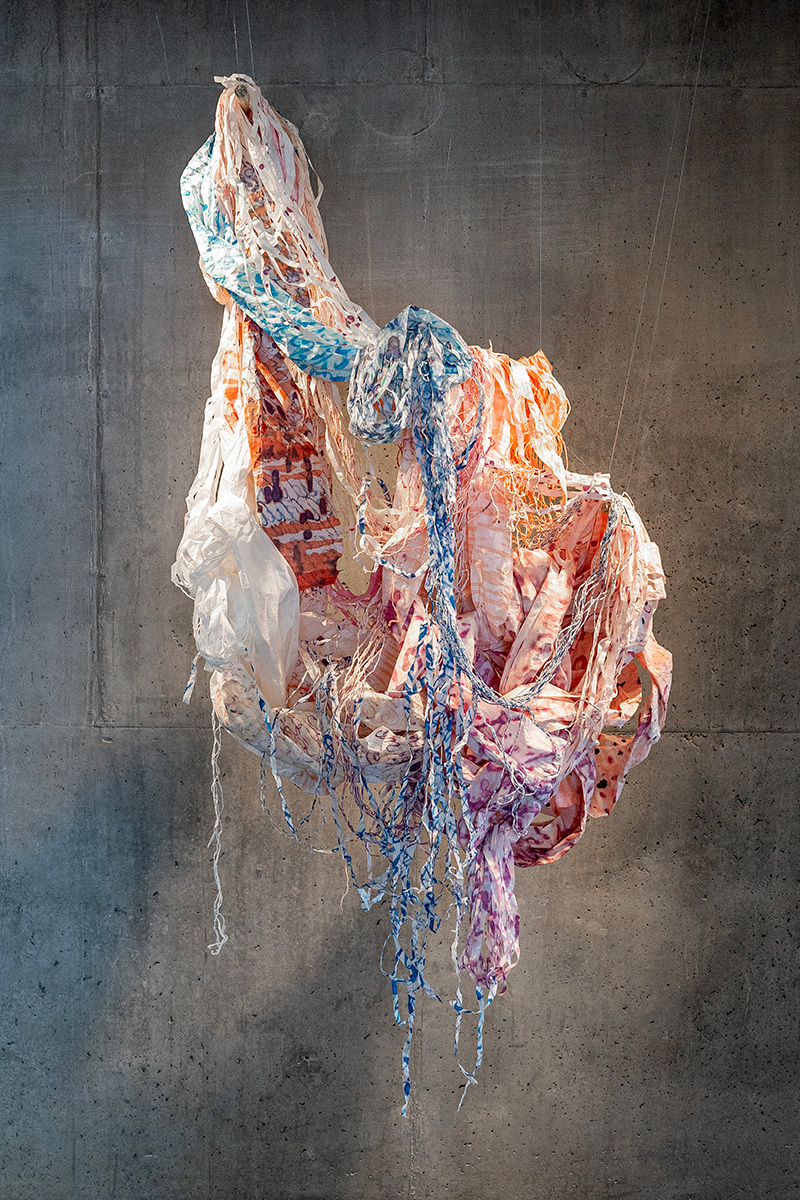
Astri Snodgrass, The Memory of the Fingers, 2024, Ink and gouache on kozo paper with handspun fringe, 60 x 38 x 11 in. Photo credit: Travis Estvold.
Gaining Perspective on Her Artistic Journey
Now, nearly a decade later, she’s discovered something surprising: the administrative side of her practice has become meaningful, even transformative. With the ability to see all her pieces in one place, she now makes time for regular reflection on her work in Artwork Archive. “It has really become part of my practice,” Snodgrass says, “allowing me to reflect on what I made over time and see through-threads that connect work spanning many years.”
Recently, that reflection led to an important realization: this year, she’ll be focusing on working towards a more sustainable art practice. “I’m thinking of sustainability holistically, relating to an arts ecosystem, how I source and use materials, how I reduce and dispose of waste, and economically, how I support my art practice through a combination of income streams.”
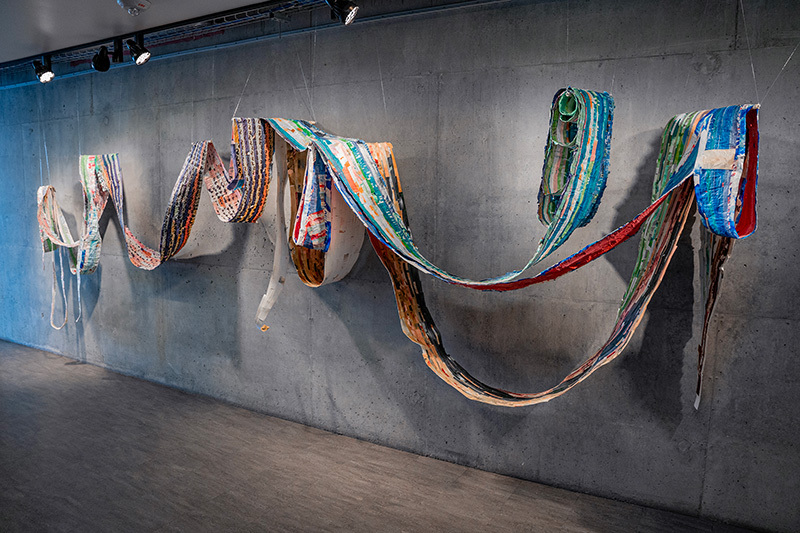
Astri Snodgrass, The Breathing Line, 2022-2024, Ink and gouache on sewn kozo paper and Rives BFK. Photo credit: Travis Estvold.
Snodgrass’s art practice is deeply connected to her family’s background and her own experiences growing up. “I learned Norwegian starting at age 10, growing up the in the US but with family ties still in Scandinavia,” she told Artwork Archive. “Learning Norwegian sparked my interest in languages in general, and I went on to study Spanish in college. I’m interested in the process of language acquisition and translation as metaphors for how I work in the studio.”
These interests have resulted in the complex, abstract pieces that she creates using playful but time-intensive processes. Her recent work uses paper to explore literacy and the relationship between text and textiles. “I’ve been making paper sculptures that utilize fiber techniques such as hand-spinning and quilting,” she explains, “and fusing this with gestural mark-making using the basic calligraphy strokes.”
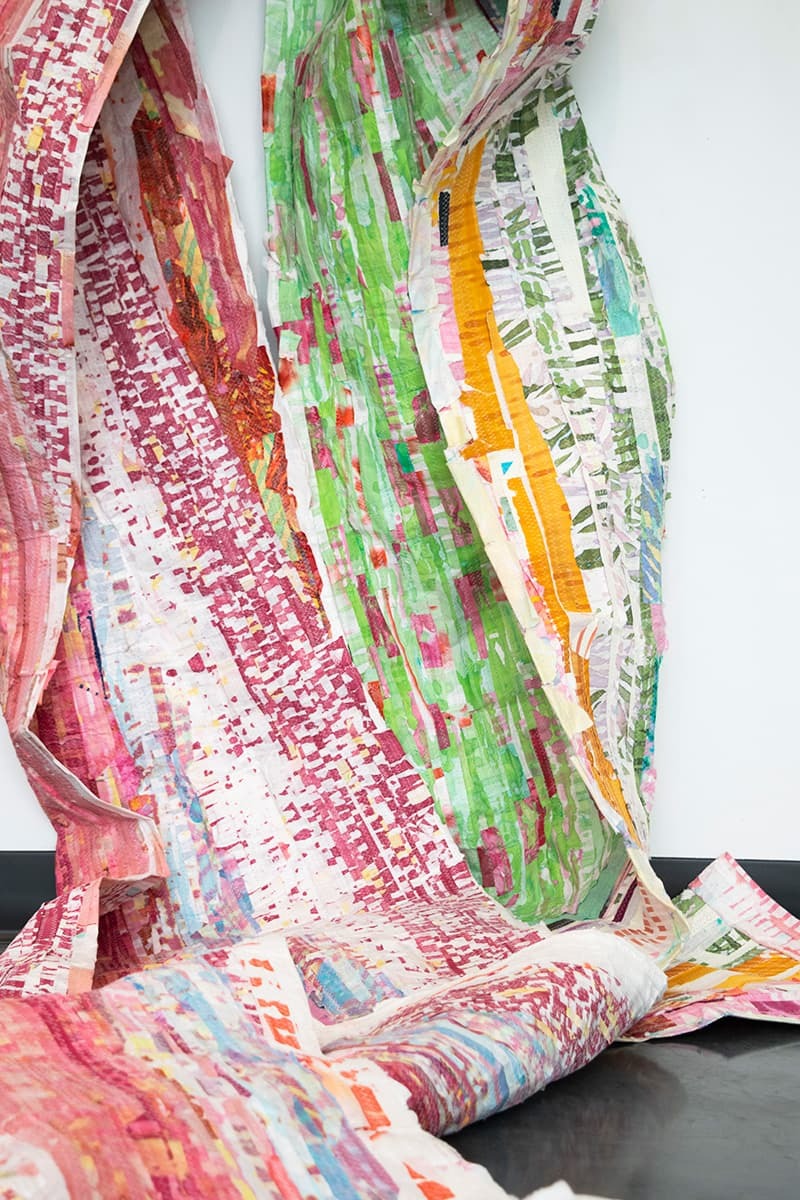
Astri Snodgrass, Language Lets Us Hold What's Changing, 2022, ink, gouache, and acrylic on sewn kozo paper, 80 x 33 x 60 in. Photo credit: Marc La Pointe.
Having all of her work in one place allows Snodgrass to act quickly when opportunities arise. Recently, a curator reached out about her crochet drawing series, wanting to show the work out of state. Using Artwork Archive’s Collections features, Snodgrass says she was able to quickly and easily drag and drop specific pieces into a succinct and clear presentation format, so the curator could focus on selecting the work best suited for the exhibition. “It cuts down on my response time when people contact me,” she explains, which makes her look professional and prepared for all the art life throws her way.
See how Collections can help you bring clarity to your artistic practice:
When a curator reaches out to Astri Snodgrass, she uses Artwork Archive's Collection functionality to quickly group her pieces, and share what she wants the curator to see. Could your work use a bit of an organization boost?
Thinking Bigger for an Art Practice and Paying It Forward
As part of her push to create a more sustainable artistic practice, Snodgrass has started to find ways to give back to the communities and causes she considers vital to her wellbeing. “I aim to use my practice as a way to live out my values,” she says. “For me, this is connected to sustainability – sustaining the kind of way I want to live, and the kind of world I want to live in.”
She recently realized that though she doesn’t have too much expendable income, she does have a lot of art, and in Artwork Archive, an easy way to present it to people. So she decided to host a special sale of her work as a fundraiser, using Artwork Archive’s Private Viewing Room feature. “Since I had already taken the time to get organized, it didn’t cost me much time or energy to carry out this fundraiser project from start to finish,” she explains. “I donated 100% of the proceeds of my sale to the Northwest Abortion Access Fund, an abortion fund supporting care for individuals in Washington, Oregon, Idaho, and Alaska. Some folks who bought my work were even new collectors.”
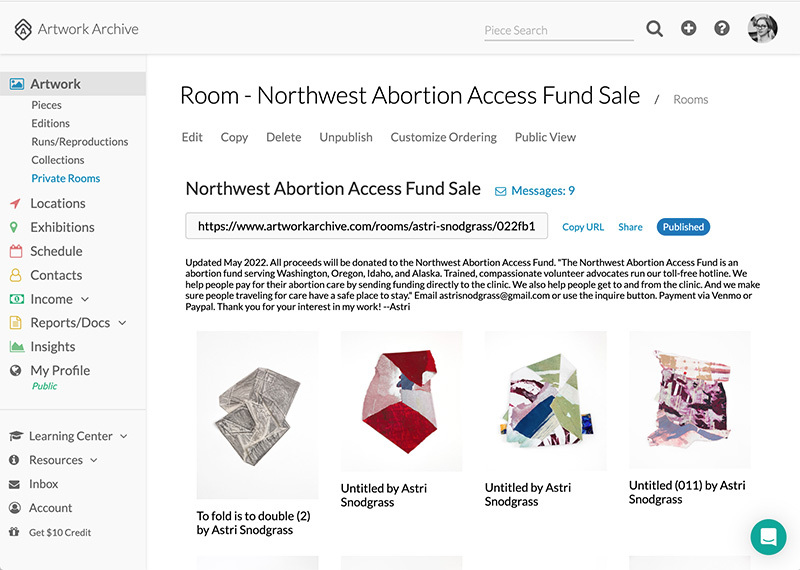
With Artwork Archive's Private Rooms function, it was simple for Snodgrass to create this selection of works for her fundraiser.
She’s also finding ways to share her knowledge with the next generation. “I am both a visual artist and an educator,” she told us, currently teaching as an Associate Professor of Drawing and Painting at Boise State University. “For me, those roles are very intertwined.” As she was transferring her messy spreadsheets into Artwork Archive, she recruited student artists who were interested in the process to join her: “I was able to show students the importance of record keeping from a holistic standpoint, as a person who not only makes art, but also supports their work through savvy practices and preparedness.”
Having the peace of mind that Artwork Archive has provided her, Snodgrass is able to focus on deepening her practice and expanding what she’s capable of as an artist. She wants to be ready for the next big opportunity to share her work, and thinking about ways to make it even more ambitious. “Right now in my practice I’m thinking about scale, and how now that I’m working much larger, I’m seeing a need to record scale, amount of materials, and time spent on a given piece to have a more accurate sense of what a public art commission or large-scale work might entail,” Snodgrass says. “This knowledge is powerful and makes me feel well-positioned to seek out those sorts of opportunities in the future.”
The Bottom Line: Organization Creates Freedom for Artists
For Snodgrass, investing in an organizational system ultimately created more creative freedom, not less. Now, she views organizing her work in Artwork Archive as essential process that enables her creative practice to thrive. “It legitimizes it, it helps combat overwhelm, it gives you all the tools you’ll need right there.”
Most importantly, Artwork Archive has given her the space for what matters most: “I find that it frees up my creative mind for the real work of creating, which is ultimately what it's all for.”
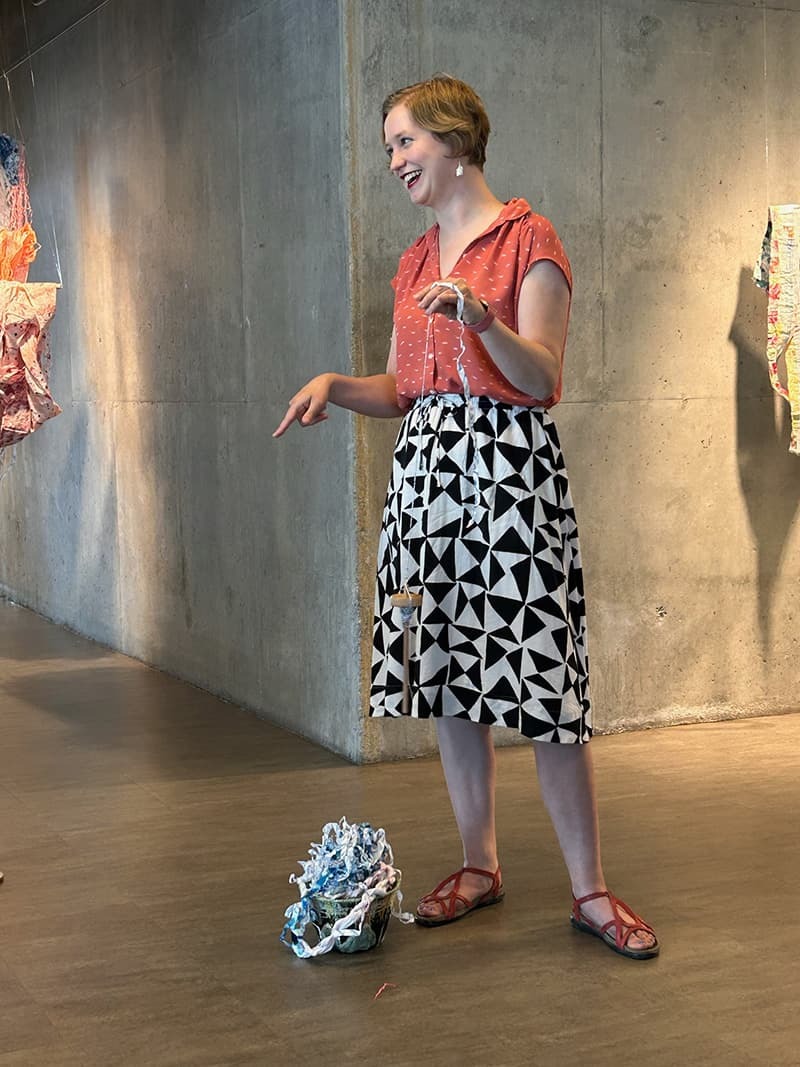
“It has really become part of my practice,” Snodgrass says of the time she spends on her Artwork Archive account. Photo credit: Sandi Moreno.
Astri Snodgrass’s Top Advice for Facing Art Business Overwhelm
If you’re an artist wanting to professionalize the administrative side of your practice, start here:
-
Creating a good inventory system now will pay dividends later: “You don’t know what you don't know, so it’s hard to keep records because at the start of a career, you don’t really know how they will benefit you and they feel like busy work. You'd rather be creating.”
-
Think of time spent organizing as creative work: “I now view the process of adding works to my inventory as a reflective practice, one that ultimately helps me. I see it as well-invested time.”
-
If you need it, don’t hesitate to get help with the initial setup: “It’s the initial push that's tricky, but given some help and dedicated time, it was well worth the investment of effort.”
Being an artist doesn't have to mean being overwhelmed:
Astri Snodgrass used to struggle with spreadsheets and missing files. Like her, you can use Artwork Archive to create Private Rooms for collectors and fundraisers, use Collections to give curators just the information they need, and keep track of high quality images of all of your work. Get started today with a 14-day free trial.
